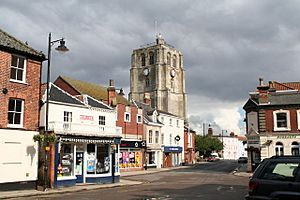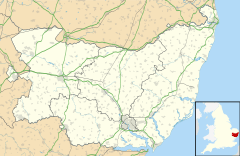Beccles facts for kids
Quick facts for kids Beccles |
|
|---|---|
 St. Michael's Church |
|
| Area | 8 km2 (3.1 sq mi) |
| Population | 10,123 (2011) |
| • Density | 1,265/km2 (3,280/sq mi) |
| OS grid reference | TM422904 |
| Civil parish |
|
| District |
|
| Shire county | |
| Region | |
| Country | England |
| Sovereign state | United Kingdom |
| Post town | BECCLES |
| Postcode district | NR34 |
| Dialling code | 01502 |
| Police | Suffolk |
| Fire | Suffolk |
| Ambulance | East of England |
| EU Parliament | East of England |
| UK Parliament |
|
| Website | http://www.beccles.info/towncouncil/ |
Beccles (pronounced BEK-əlz) is a lively market town in Suffolk, England. It's located in the East Suffolk area. You can find it about 16 kilometres (10 miles) south-east of Norwich and 33 kilometres (21 miles) north-northeast of Ipswich.
The town sits right on the River Waveney, which is part of The Broads National Park. This makes Beccles a popular spot for boating and enjoying nature. In 2011, about 10,123 people lived in Beccles. If you include the nearby area of Worlingham, the total population is around 13,868. Beccles has a special friendship with Petit-Couronne in France, a connection they made in 1978.
Contents
Discovering Beccles: A Look at Its Past
Beccles has a long and interesting history. Its name, 'Beccles', was first written down in a very old book called the Domesday Book in 1086. The name likely comes from old English words meaning 'pasture on the stream'. This makes sense because Beccles is right by the River Waveney.
How Beccles Became a Town
Beccles was once a busy river port, a place where boats would come and go. Queen Elizabeth I officially made Beccles a town on 2 July 1584. This meant it could govern itself. Later, King James I confirmed this special status in 1605.
Famous People Connected to Beccles
Many notable people have links to Beccles. Sir John Leman, who lived in the 1600s, was a successful businessman from Beccles. He even became the Lord Mayor of London.
The Peck family has also been important in Beccles for a long time. One member, Rev. Robert Peck, was a Puritan leader. He had to leave England for a while and went to America. He later returned to Beccles. His daughter, Ann Peck, married John Mason, a leader in early American history.
In 1794, a famous French writer named François-René de Chateaubriand lived in Beccles while he was in exile. He taught French here and fell in love with a local woman.
Exploring Beccles: Important Buildings and Places
When you walk around Beccles town centre, you'll notice many streets end with 'gate'. This comes from an old Norse word for 'street'.
St Michael's Church and Bell Tower
The most striking building in Beccles is the tall, separate bell tower of St Michael's Church. This tower was built in the 1500s and stands about 30 metres (97 feet) high. The church itself was built in the 1300s. It was damaged by fire in 1586 but was rebuilt. Both the church and its tower are very old and important buildings.
Many famous people have connections to this church. Catherine Suckling married a former Beccles priest here in 1749. Her son became the famous naval hero, Horatio Nelson. The poet George Crabbe also got married at St Michael's Church.
Beccles Town Hall
Right across from the church is Beccles Town Hall. It's built where the town's old market cross used to be. This area, called Newmarket, still hosts a weekly market today.
Beccles Museum
The Beccles Museum is located in Leman House, a beautiful old building from the 1500s. This building was once the town's Grammar School. It was named after John Leman, who left money to support it after he died in 1631.
Beccles Common and Boney's Island
Beccles Common is a large open area to the north-west of the town. You can find a World War Two Pillbox (a small concrete fort) here, built around 1940. In the middle of the Common is Boney's Island, a small hill. Some say it was a camp for prisoners during the Napoleonic Wars. Others believe a big bonfire was lit there to celebrate the end of those wars in 1814.
Getting Around Beccles: Transport Options
Beccles has several ways to get around, connecting it to other towns and cities.
Buses
Local bus services connect Beccles to nearby places like Norwich, Lowestoft, Great Yarmouth, Bungay, and Southwold.
Railway
Beccles railway station is on the East Suffolk Line, which runs between Ipswich and Lowestoft. Trains run every hour on weekdays. In 2012, a special rail loop was added at Beccles. This allows trains to pass each other, which is important for keeping services running smoothly.
Air Travel
Beccles Airfield is about 3 kilometres (2 miles) south-east of the town. It was built during World War Two. Today, it's used for light aircraft and parachuting.
Cycling
If you enjoy cycling, Beccles is on National Cycle Route 1, which goes all the way from London to the Orkney Islands. Other regional cycle routes also pass through the town.
Roads
The A146 road bypasses Beccles to the north, helping traffic flow around the town. The A145 road also connects to the town.
Beccles Southern Relief Road
A new road, the Beccles Southern Relief Road, opened in 2018. This road helps heavy vehicles avoid the narrow streets of the town centre. It connects the A145 to the A146, making journeys safer and reducing traffic in Beccles.
Learning in Beccles: Schools and Education
Beccles has schools for all ages.
Secondary Schools
For older students (ages 11-18), there is Sir John Leman High School. SET Beccles School also teaches students aged 11-16. Both schools welcome children from Beccles and the surrounding villages. Sir John Leman High School has been around since 1632.
Primary Schools
Younger children (ages 5-11) attend one of three primary schools in Beccles: Beccles Primary Academy, St Benet's Catholic Primary School, and The Albert Pye School.
Fun in Beccles: Leisure and Activities
Beccles offers many activities for residents and visitors.
Beccles Carnival
Every August, the town hosts the annual Beccles Carnival and Family Fun weekend. A popular event during this weekend is the Duck Race on the River Waveney!
Local News
The local newspaper for Beccles is the weekly Beccles & Bungay Journal, which started in 1933.
Youth Groups
There are several groups for young people in Beccles, including two Scout Association groups and Girlguiding groups. You can also find Beccles Sea Cadets, Beccles Royal Marines Cadets, and 759 (Beccles) Air Cadets.
Sports Clubs
Beccles has a Cricket Club, founded in 1955. They have teams for men, women, and juniors. The main football club is Beccles Town, started in 1919. Another local football team is Beccles Caxton.
For kart racing fans, Ellough Park Raceway is just outside Beccles.
Well-Known People from Beccles
Many interesting people have come from or lived in Beccles, including:
- Claude Auchinleck, a general during the Second World War.
- Martin Bell, a retired BBC journalist.
- Hester Burton, a children's author.
- Jordan Catchpole, a British Paralympic swimmer who won a gold medal in 2020.
- David Frost, a famous broadcaster.
- Dorothy Hodgkin, a Nobel Prize winner.
- Chris Martin, a professional footballer.
Images for kids
See also
 In Spanish: Beccles para niños
In Spanish: Beccles para niños







